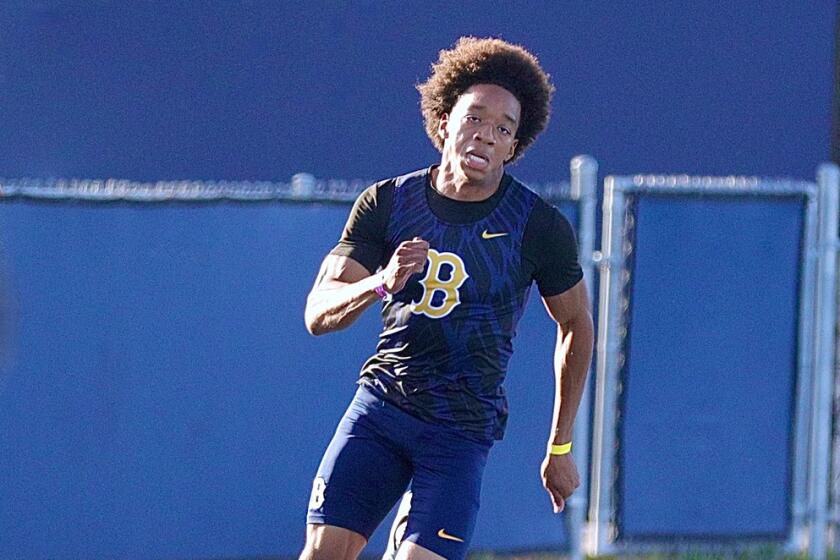Coaches Speak Out Against New Rule on Sideline Activity
- Share via
Picture this:
Katella High School is playing El Dorado in the Golden Hawks’ gym with the winner gaining the Empire League championship.
Katella is behind by one point, 70-69, with no timeouts remaining. With 10 seconds to play, Katella’s Bob Erbst is fouled driving to the basket, but the referees don’t call it and El Dorado subsequently recovers the ball.
Tom Danley, Katella’s coach, sits calmly on the sidelines, encouraging his team to try to steal the ball back in the time remaining.
Now, there is something wrong with this picture. There is definitely something wrong with this picture.
Anyone familiar with Danley knows that he probably would be on his feet shouting at the referees as well as his players, expressing his displeasure with arms extended, wearing a “How-could-you-miss-that-call?” expression.
The pre-1985 Tom Danley might’ve reacted that way, but no more.
Thanks to the most recent interpretation of an old rule, sideline activities and movement by coaches will fall under close scrutiny.
No more leaning onto the court to shout instructions. No more getting in the referee’s face to express an opinion. No more jumping up and down. No more waving a towel at the crowd.
Rarely has a rules change upset local basketball coaches as much as the More Restricted Bench Rule (Rule 10-5), the modified version of which goes into effect for the 1985-86 season.
There always has been a general bench decorum rule, but the latest version of the rule puts more teeth into it.
Part of the anxiety over the rule, written by the National Rules Committee and adopted by the California Interscholastic Federation, is that some exceptions are allowed, and coaches are worried how various referees will interpret them.
Rule 10-5 states “The Coach must remain seated while the clock is stopped or running, except to:
“--Confer within the bench area with players and squad members during a charged timeout or intermission between quarters.
“--To rise and signal a timeout from in front of the seat.
“--Confer at the scorer’s table to request a correctable timeout.
“--Attend an injured player when beckoned onto the court.
“--Remove or replace a disqualified or injured player.”
The penalty for violating the rule is a two-shot technical foul. Also, technical fouls called on bench personnel (players, trainers, assistants) will be charged to the head coach as well.
Several Orange County basketball coaches said they did not favor the changes, particularly because they were not consulted.
Mater Dei’s Gary McKnight: “I haven’t seen that out-of-line coaches have been a real problem in Orange County. The intent of the rule is probably good, but the game shouldn’t be decided by whether the coach is standing up or not.
“There’s a big difference between chewing on the referees and coaching. I think the good referees will just pay more attention to what’s happening on the court.
“Why wasn’t a questionnaire sent out to us to see if we wanted the rule or not? They did that for the timeout rule (four timeouts nationally versus five for CIF games).”
Danley: “They should put the emphasis on the officials’ officiating the game and not officiating the coaches. I will abide by the rule. I may not agree with it, but I’ll abide by it. What I’ll also do is work for a change toward a coaching box.
“It’s one thing to be giving the officials a bad time, but another if you’re just coaching and not interfering with the game. Us older coaches who’ve been around, we do like to get up and move around.”
Members of the National Rules Committee said that standing, demonstrative coaches often incite the crowd. And when one coach sees his rival up and shouting, he often feels forced to jump up and make his presence felt as well.
The committee felt such behavior has taken the focus off the court and onto the sidelines.
Said referee Speedy Castillo, instructional chairman of the Orange County Officials Assn.: “The rule is asinine. It’s a strong, strict rule to enforce, no doubt about that. But the rule is there and it must be enforced, so that’s all there is to it.
“My people have been instructed to use a little discretion and dignity in enforcing it, however.”
Bill Shannon at Woodbridge cited one alternative for coaches who are used to patrolling the sidelines.
Shannon: “I was at a tournament at Nevada Las Vegas once and met a coach who was an assistant at the University of Pittsburgh, which had once played under the ‘sit down’ rule.
“He said the coaches there wore roller skates and put seat belts on their chairs and then rolled up and down the sidelines to show how ridiculous the rule was.
“So, now they have a coaches box. Maybe we should do something like that.”
More to Read
Get our high school sports newsletter
Prep Rally is devoted to the SoCal high school sports experience, bringing you scores, stories and a behind-the-scenes look at what makes prep sports so popular.
You may occasionally receive promotional content from the Los Angeles Times.





